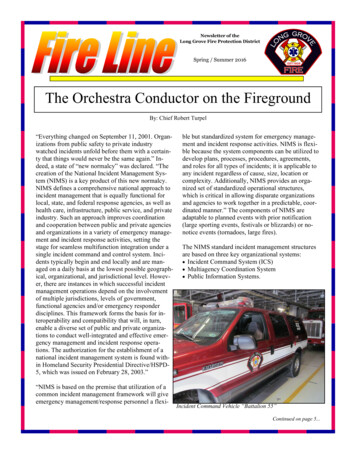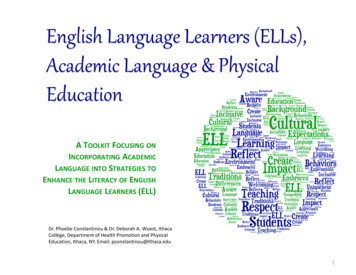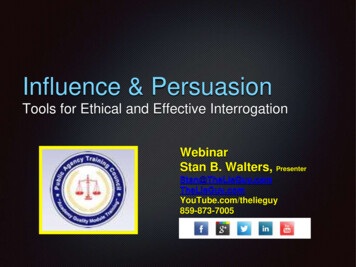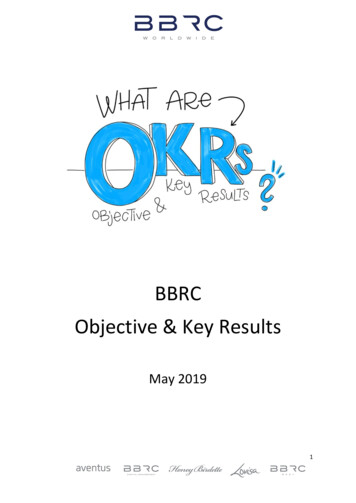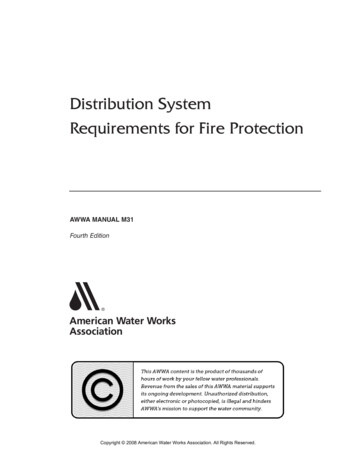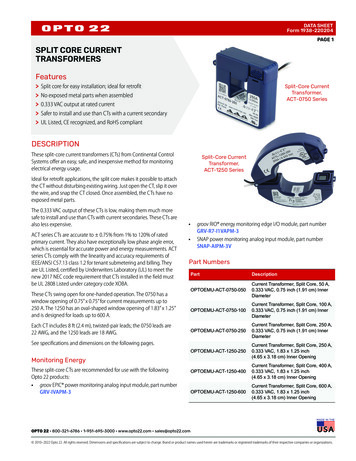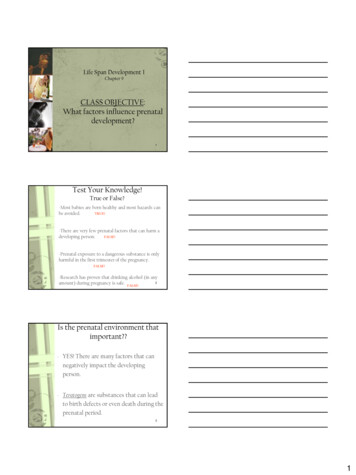
Transcription
Life Span Development IChapter 9CLASS OBJECTIVE:What factors influence prenataldevelopment?1Test Your Knowledge!True or False?‐Most babies are born healthy and most hazards canTRUE!be avoided.‐There are very few prenatal factors that can harm aFALSE!developing person.‐Prenatal exposure to a dangerous substance is onlyharmful in the first trimester of the pregnancy.FALSE!‐Research has proven that drinking alcohol (in any2amount) during pregnancy is safe. FALSE!Is the prenatal environment thatimportant?‐YES! There are many factors that cannegatively impact the developingperson.‐Teratogens are substances that can leadto birth defects or even death during theprenatal period.31
Think on your own What are some factors thatcould influence prenataldevelopment?4What are some factors that wouldinfluence prenatal development?‐‐‐‐‐‐‐‐Drugs (street or over the counter)AlcoholCigarettesDiseasePoor nutritionStressorsChemicalsAlmost anything can impact a developingfetus5It’s all about timing ‐The effect of a teratogen is very personal becausethe impact depends on the timing of exposure.‐Critical period is the time when a particularorgan or body part is the most susceptible todamage‐Different teratogens can cause damage atdifferent times during development and eachbody structure has its own critical period 62
7Fetal Alcohol Syndrome (FAS)This syndrome is caused by a motherdrinking excessive amounts of alcoholduring pregnancy.‐Heavy drinking during the second trimesterseems to cause more features of FAS.‐Particularly weeks 10-208What does FAS look like?‐Facial Characteristics‐Flattened features‐Low-set ears‐Down syndrome-like appearance93
Facial abnormalities are anobvious indicator of FAS‐‐Small head circumference‐Small, widely-spaced eyes‐Prolongation of the fold ofthe upper eyelid‐A short, upturned nose‐Flat mid-face, lowerednasal bridge‐Thin upper lip10Approximately 10,000 infants are borneach year with physical or cognitivedisabilities associated with maternaldrinking (Jacobson, 1997).‐Every 1 in 750 births11The presence of alcohol in the fetus’sbloodstream triggers widespread cell death inthe fetal brain.Normal brain of6-week-old babyBrain of 6-week-oldbaby with FAS124
When is the CNS most vulnerable?13Other Factors‐Nutrition‐Especially folic acid‐Maternal age‐ Negatively affect development if mom is anadolescent or over the age of 35‐Emotional states and stress‐ When a pregnant woman experienceintense fears, anxieties, and other emotions– physiological changes occur that mayaffect her fetus14How do infants experience theworld?Objectives:What senses do newborn babies have?What are Primary Reflexes?155
After birth the period ofInfancy beginsBirth to 18 months16Infants are born with innateprimary reflexes:‐ These are unlearned responses to stimuliand most disappear over the first year oflife.‐Indicate whether the newborn’s nervous system isworking properly.‐They can also be used to assess development duringinfancy17The Primary Reflexes1.The Babinski Reflex causes the toes to fan when the sole of thefoot is touched.2.The Moro reflex causes the newborn to stretch out thearms and legs and cry in response to a loud noise.3.In the Rooting reflex, the head is turned toward a touch onlips or cheek.4.The Sucking reflex will reflexively occur in response to fingeror nipple in mouth.5.The Grasping reflex causes newborn to grasp any objecttouching the palm or fingers.186
How we develop attachment?Ch.10-Life Span Development II19CLASS OBJECTIVES-What is attachment?-How and why do we developattachment relationships?20What was Your firstattachment relationship?217
The first special relationshipwe experience developsbetween parent and childIt is believed that this relationship willinfluence the development of ourfuture relationships22What is Attachment?Attachment is a strong, long-lastingemotional connection‐A close emotional bond that is “personspecific” and is enduring across time.23How do you know an infantis attached to someone?Infants show their attachment throughproximity-seeking behaviors, meaninginfants like to be near those we are24attached.8
How does love developbetween mother andchild?Harry Harlow studied the impact ofsecurity and “contact comfort” on infantattachment.25Harry Harlow (1959)“The Monkey Love experiments”Harlow evaluated whetherfeeding or contact comfortwas more important toinfant attachment.‐The young animals were“raised” by two kinds ofsurrogate monkey mothermachines.One mother was made ofsoft terry cloth, the othermade of wire mesh26“Monkey Love Experiments”‐Harlow's research showed thatthe need for affection created astronger bond between motherand infant than did physicalneeds (food).279
Harlow’s work suggestedthat the development of achild’s love for their caregiverwas emotional rather thanphysiological28What does this mean for humans?Harlow showed that the development ofattachment was closely associated with criticalperiods in early life.‐It is difficult or impossible to compensate for the loss of initialemotional security‐Further experiments on abusive conditionsshowed that no matter how abusive the “IronMaidens” were, the baby monkeys always cameback and displayed affection towards them.‐Even in the face of abuse, the need for lovewas overwhelming29‐What happened to these monkeys?‐Monkeys raised without their mothers weresocially maladjusted the rest of their lives.‐‐“When confronted with fear, they displayedautistic and institutionalized behaviorsthrowing themselves on the floor, clutchedthemselves, rocked back and forth, andscreamed in terror.”They were incapable of having sexual relationsand they were also unable to parent theiroffspring, either abusing or neglecting them.3010
"Not even in our mostdevious dreams could wehave designed a surrogateas evil as these real monkeymothers were."31Are all AttachmentRelationships theSame?32The Quality of Attachment‐Based on how the infant reacts toseparation from the caregiver and thereunion by using a procedure known asthe Strange Situation.‐Ainsworth (1993) and others haveidentified 4 basic types of attachmentrelationships1.2.3.4.Secure ure/Disorganized3311
34Types of AttachmentSecure attachment is a relationship oftrust and confidence with a pattern ofattachment that involves a highquality, relatively unambivalentrelationship with their caregiver‐‐This group seems to say “I missed you terribly,but now that you’re back, I’m okay.”‐60-65% of American children have secure attachmentrelationships (Kail, 2007).35A secure attachmentrelationship is likely todevelop when parentsrespond to their infant’sneeds reliably andsensitively3612
Insecure/Resistant‐A pattern of insecure attachment in whichinfants or young children are clingy andstay close to their caregivers rather thanexploring their environment‐The baby is upset when the mother leaves andremains upset or even angry when she returns,and is difficult to console37Insecure/Avoidant‐A pattern of insecure attachment in whichinfants or young children seem somewhatindifferent toward their caregivers and mayeven avoid their caregivers‐The baby is not upset when the mother leaves, and,when she returns, may ignore her by looking orturning away38If they do get upset whenleft alone, they are as easilycomforted by a stranger asby a parent.20% of middle-class Americanchildren are in insecure/avoidantrelationships.3913
Next ClassHow does our thinking develop?-Cognitive development4014
Insecure/Resistant ‐ A pattern of insecure attachment in which infants or young children are clingy and stay close to their caregivers rather than exploring their environment ‐ The baby is upset when the mother leaves and remains upset or even angry when she returns, and is difficult to console 38 Insecure/Avoidant
